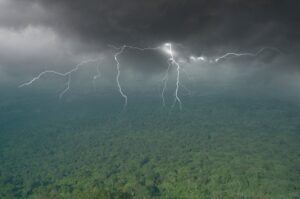French composer Pierre Schaeffer said that “sound is the vocabulary of nature.” Nature’s loudest sounds are some of the most powerful testimonies to our planet’s natural history and incredible capabilities. From deafening volcanic explosions to cosmic airbursts, these are the loudest natural sounds ever recorded.
The Krakatoa eruption of 1883
To this day, the 1883 Krakatoa eruption remains at the top of the list of loudest sounds ever recorded. This fierce eruption obliterated more than half of the island on which the volcano stood, completely reshaping it and creating a new archipelago with several other islands.
The eruption went on for five months (May to October), with its peak period in late August. The most powerful explosion was equivalent to over 200 megatons of TNT, making it much more powerful than a nuclear bomb.

Krakatoa eruption illustration. Photo: Parker & Coward (1888)
The eruption spewed copious amounts of ash and sulfur 27km into the atmosphere, caused intense seismic activity, and generated 46m tsunami waves. According to reports, the volcano’s eruption was audible 5,000km away. People as far away as Australia and Mauritius reported hearing it.
The sound of the explosion measured 230 to 310dB and it is estimated 36,417 people died. Captain Sampson of the ship Norham Castle wrote that “so violent are the explosions that the eardrums of over half my crew have been shattered.”
Additionally, the pressure wave triggered by the eruption traveled around the globe three times, with barographs picking up crazy spikes in atmospheric pressure.
The Bloop
The loudest underwater sound ever recorded was a mysterious low-frequency noise nicknamed “The Bloop” by the National Oceanic and Atmospheric Administration (NOAA). The sound was captured by the Equatorial Pacific Ocean Autonomous Hydrophone Array in 1997 off the coast of Chile. It lasted for only a minute but traveled over 5,000km. The unusual sound led to many conspiracy theories.
Some people believed The Bloop was produced by an extremely large undiscovered marine animal. Others believed the sound could have come from whales or military activity. However, oceanographers concluded that it was most likely cryoseism, also known as an ice quake. An ice quake is when an iceberg breaks apart or when ice breaks off a glacier. This can cause a sound wave to travel great distances in the water.
The NOAA believes the sound originated between the Bransfield Straits and the Ross Sea in Antarctica.
Julia
Like The Bloop, the Equatorial Pacific Ocean Autonomous Hydrophone Array captured “Julia”. The sound was recorded in 1999 off the Pacific coast of South America and its range was around 5,000km. But this sound proved harder to pin down. The sound is haunting and listeners have suggested that it sounds like an animal’s lonely howl.
At around the same time, a satellite image (alleged to be from NASA) started to circulate showing an enormous shadowy creature. Unsurprisingly, the photo proved to be a hoax. Nevertheless, this didn’t stop people from believing that a mythical Cthulhuesque cryptid lurked in the depths.
Scientists believe that Julia and The Bloop are both ice quakes that originated from the same area.
Other loud sounds picked up by hydrophones include the “Upsweep”, “Whistle”, “Train”, and “Slow Down”. Researchers have identified that some of these were also created by ice quakes.
Tunguska event
In 1908, those living in Siberia witnessed Earth’s most powerful meteor air burst/impact event. The Tunguska event had a force of up to 30 megatons of TNT, obliterating a 60m asteroid 10km high in the air. The explosion’s sound was a painful, earth-shattering, 315dB.
The shock wave injured many people, destroyed property, and famously flattened forests. The impact was heard and felt hundreds of kilometers away. Some people passed out from shock, others permanently lost their hearing.

Flattened trees at Tunguska. Photo: NASA
Eyewitness accounts reported various sounds as the meteor streaked across the sky and eventually exploded. A man named S. Semenov described it “as if rocks were falling or cannons were firing.” A man named Chuchan of the Chanyagir Tribe noted multiple thunderclaps. Then, the 315dB grand finale came. A firearm going off creates around 140dB and is extremely loud. Over 300dB is likely to cause permanent hearing loss and even death!
Chelyabinsk Cosmic Burst
In 2013, the 9,100-tonne Chelyabinsk meteor traversed the skies above Russia’s southern Ural region. During atmospheric entry, the icy meteorite exploded, sending incredible shockwaves through the region. The sound measured 180dB from 4.8km away and the explosion produced an energy output equivalent to 500 kilotons of TNT.

Chelyabinsk smoke trail. Photo: Alex Alishevskikh/Wikipedia Commons
According to the Daily Mail, the Comprehensive Nuclear Test Ban Treaty Organization declared the event the loudest infrasound ever recorded. Sensors in remote regions like Antarctica picked up on the infrasonic waves emitted by the blast.






